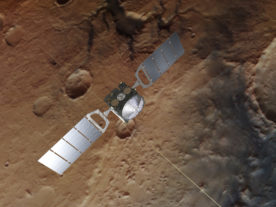Soon after the October 2017 discovery of Oumuamua, the first confirmed interstellar object to visit our solar system, rumors and conspiracy theories began popping up all over the Internet.
Because of its suspected origins, as well as its odd, flat, cigar-shaped appearance, word started to spread that the object was actually an alien interstellar space probe, possibly carrying intelligent extraterrestrial life.

One of the tiles making up the 32T, a prototype instrument for the Murchison Widefield Array in Western Australia. (Natasha Hurley-Walker/Creative Commons Attribution-Share Alike 3.0 Unported via Wikimedia Commons)
After a number of investigations by scientists from around the world, the alien spacecraft rumor/conspiracy theory was put to rest.
Radio astronomers at the Murchison Widefield Array telescope in Western Australia joined other scientists’ efforts to learn more about the object.
So they went back and checked their radio telescope’s observations of the object to see if they could detect any radio transmissions coming from the interstellar visitor.
After scanning radio frequencies from 72 to 102 MHz, the same band FM radio uses, the scientists say they did not find any signs of intelligent life emanating from Oumuamua.
Rather than just searching for extra-terrestrial intelligence from distant stars, the Australian scientists say the research they conducted into the mysterious space object helped them to expand the search for ETI to objects a bit closer to home.

Shown in 7-day increments, this is the trajectory of ʻOumuamua as it passed through the inner Solar System. It reached its closest point with the Sun or perihelion on September 9, 2017. It was discovered 40 days later, on October 19, 2017. ( Tom Ruen, data from NASA/JPL Horizons/Creative Commons-Attribution-ShareAlike 4.0 International via Wikimedia Commons)
Oumuamua, Hawaiian for scout or messenger, was discovered on October 19, 2017, by astronomer Robert Weryk, who used the Pan-STARRS telescope at the Haleakala Observatory located near the summit of Haleakala on the Island of Maui, Hawaii.
It’s thought that the interstellar object made its closest approach to the Sun on September 9, 2017.
Scientists sat that Oumuamua has a dark reddish exterior and have calculated that it is less than 400 meters in diameter.
When it was discovered scientists say it was traveling at a speed of about 44 kilometers per second.
The object’s interstelar orgin was determined after scientists studied its speed and trajectory.
























Comments are closed.